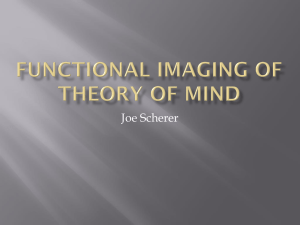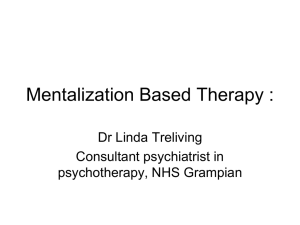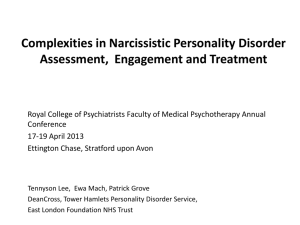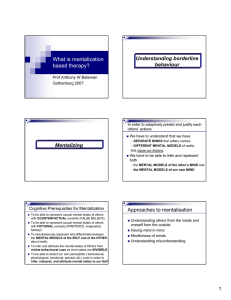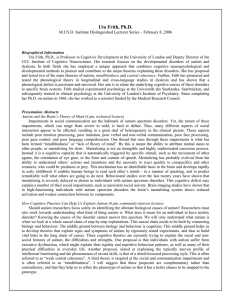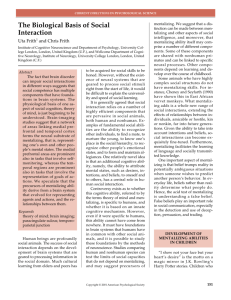Mentalizing problems in children and adolescents Chapter 2 Carla Sharp and Amanda Venta
advertisement
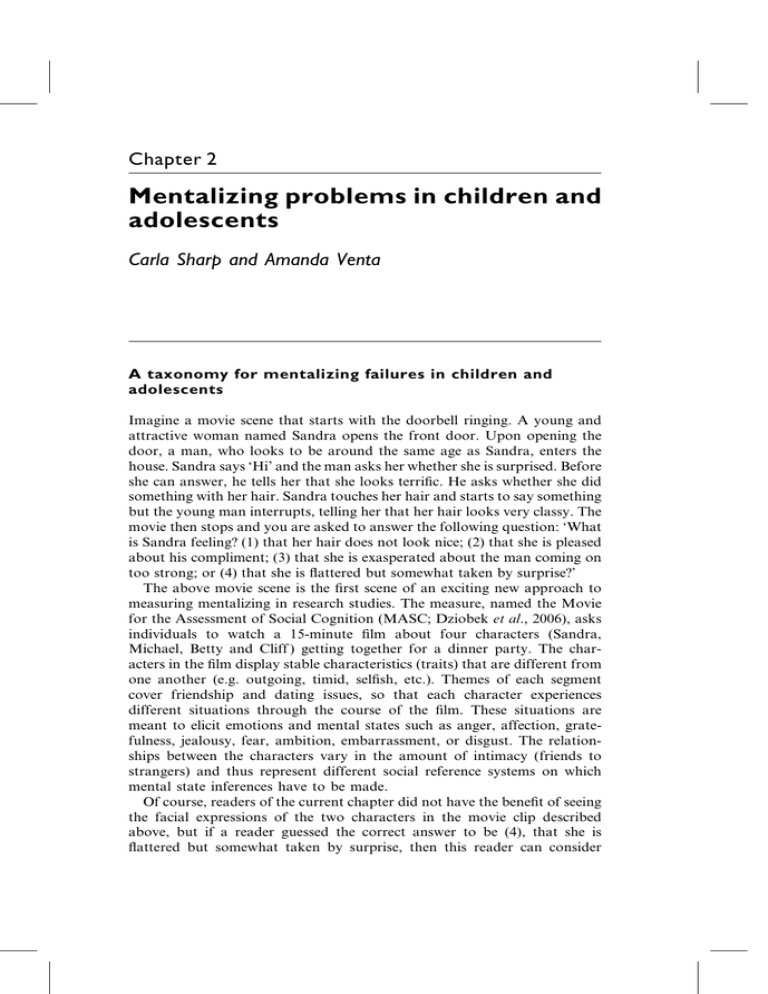
Chapter 2 Mentalizing problems in children and adolescents Carla Sharp and Amanda Venta A taxonomy for mentalizing failures in children and adolescents Imagine a movie scene that starts with the doorbell ringing. A young and attractive woman named Sandra opens the front door. Upon opening the door, a man, who looks to be around the same age as Sandra, enters the house. Sandra says `Hi' and the man asks her whether she is surprised. Before she can answer, he tells her that she looks terri®c. He asks whether she did something with her hair. Sandra touches her hair and starts to say something but the young man interrupts, telling her that her hair looks very classy. The movie then stops and you are asked to answer the following question: `What is Sandra feeling? (1) that her hair does not look nice; (2) that she is pleased about his compliment; (3) that she is exasperated about the man coming on too strong; or (4) that she is ¯attered but somewhat taken by surprise?' The above movie scene is the ®rst scene of an exciting new approach to measuring mentalizing in research studies. The measure, named the Movie for the Assessment of Social Cognition (MASC; Dziobek et al., 2006), asks individuals to watch a 15-minute ®lm about four characters (Sandra, Michael, Betty and Cliff ) getting together for a dinner party. The characters in the ®lm display stable characteristics (traits) that are different from one another (e.g. outgoing, timid, sel®sh, etc.). Themes of each segment cover friendship and dating issues, so that each character experiences different situations through the course of the ®lm. These situations are meant to elicit emotions and mental states such as anger, affection, gratefulness, jealousy, fear, ambition, embarrassment, or disgust. The relationships between the characters vary in the amount of intimacy (friends to strangers) and thus represent different social reference systems on which mental state inferences have to be made. Of course, readers of the current chapter did not have the bene®t of seeing the facial expressions of the two characters in the movie clip described above, but if a reader guessed the correct answer to be (4), that she is ¯attered but somewhat taken by surprise, then this reader can consider 36 Minding the child herself a good and accurate mentalizer. According to the MASC developers, the other three categories of mentalizing include no theory of mind or no mentalizing (Sandra felt that her hair does not look nice); less theory of mind or under-mentalizing (Sandra felt pleased about his compliment) and excessive theory of mind or hyper-mentalizing (Sandra felt exasperated about the man coming on too strong). We may add to this list the concepts of distorted mentalizing (Sharp, 2006) and pseudo-mentalizing (Allen et al., 2008). We will return to de®nitions of each type of mentalizing failure later in the chapter, but brie¯y, distorted mentalizing refers to mind misreading (Allen, 2006) or biased mindreading (Sharp et al., 2007) where mental states are attributed to other minds, but in a systematically biased way. Pseudomentalizing refers to mindreading that looks like mentalizing, but lacks some of the essential features of genuine mentalizing (Allen et al., 2008). It is clear from the above that, beyond a complete lack of mentalizing, there are multiple ways in which mentalizing can go awry ± collectively (and in jest) referred to by Allen et al. Bateman (2008: 30) as `excrementalizing: mentalizing, but doing a crappy job of it'. In this chapter, we will review mentalizing problems in children and adolescents using the taxonomy outlined above. Our goal is thereby: (1) to establish mentalizing as an important endophenotype to be targeted in treatment; and (2) to illuminate how different aspects of mentalizing are re¯ected in the heterogeneity of different childhood disorders. Taken together, the current chapter will emphasize the importance of targeting and measuring change in treatment via mentalizing failures across divergent childhood and adolescent disorders. No mentalizing: Are autistic individuals mindblind? The term mentalizing is often used interchangeably with the concept of theory of mind (ToM). The ToM framework has been associated with one of the fastest growing bodies of empirical research in psychology over the last 30 years (Leudar & Costall, 2010), and it is within this framework that the notion of `no mentalizing' underlying autistic spectrum disorders (ASDs) has been investigated. Most researchers in this area take a cognitive modularist view of mentalizing, akin to Chomsky's (1980) conceptualization of language development as a set of linguistic schemata that are hardwired in the structure of the human brain. At its most extreme, modularist researchers view autism as an example of a clinical condition where the ToM module has been excised as though by a lesion (Belmonte, 2008). The ®rst evidence for the notion that autistic individuals may lack a ToM module was provided in a now much-cited study by Baron-Cohen et al. (1985). A group of 11-year-old autistic children was compared with agematched children with Down's syndrome and four-year-old clinically normal children on a `false belief' task. During the task, a doll character (Sally) placed an object in a basket. Then, another character (Anne) hid the Mentalizing problems in children and adolescents 37 object in a different location while Sally was out of the room. Participants were asked where Sally would look for the object on return. Results indicated that, despite the fact that the mental age of the autistic children was higher than that of the Down's syndrome and normal controls, 80 per cent of the autistic children were unable to demonstrate an understanding of Sally's false belief regarding the object's location, while the majority of Down's syndrome and normal subjects did. The authors concluded that autistic children may lack the capacity to build theories on the content (beliefs or false beliefs) of others' minds ± a de®cit famously coined `mindblindness' (Baron-Cohen, 1995). Undermentalizing: Not enough of a good thing Despite initial evidence for a complete lack of ToM associated with autism, evidence also appeared indicating that a signi®cant number of autistic children and adolescents passed false belief tasks (Frith & HappeÂ, 1994). Moreover, many ToM researchers started reformulating the concept within a continuum of variation, as opposed to viewing it categorically. For instance, Baron-Cohen and colleagues (Baron-Cohen et al., 2003; BaronCohen & Wheelright, 2004) developed an approach to mentalizing where ToM became a lower level module of a broader continuum of `empathizing' capacity. In this approach, autistic children can be situated on an empathizing continuum, albeit at its lower extreme. Further expanding the continuum view of ToM was a growing literature demonstrating impairments in even lower level modules preceding the development of ToM subsumed under the broad continuum of empathizing. For instance, autistic infants have demonstrated a general lack of social interest, reduced levels of social engagement and social-communicative exchanges, limited eye contact and less visual attention to social stimuli (Volkmar et al., 2005). Moreover, reduced mentalizing continued through the toddler years in autistic children. Two-year-olds with autism were shown to be more limited in imitation, pretend play and symbolic representation of a shared object (Charman & Baron-Cohen, 1997; Charman et al., 1997; Roeyers et al., 1998) ± a limitation that was demonstrated even for older children with autism (Hobson & Lee, 1999; Loveland & Tunali, 1994; Smith & Bryson, 1994). These children are less likely to make mental-physical or appearance-reality distinctions, and are less likely to understand the functions of the brain or mind (Baron-Cohen, 1989). They perform less well on `seeing-leads-to-knowing' tests1 (Baron-Cohen & Goodhart, 1994) and 1 Seeing-leads-to-knowing' or `see-know' tests assess children's understanding that visual access to information is a way of gaining knowledge of that information (Wimmer et al., 1988). In a typical `seeing-leads-to-knowing' task, participants are given a story about two characters, and are required to ascribe knowledge or ignorance of the contents of an opaque box to characters who either have or have not looked inside the box. 38 Minding the child are worse at distinguishing mental from non-mental verbs (Baron-Cohen et al., 1994). They exhibit less spontaneous pretend play (Baron-Cohen, 1987), display dif®culties in understanding complex mental states (Baron-Cohen, 1991), have trouble following gaze direction (Leekam & Perner, 1991), have reduced insight into deception (Yirmiya & Shulman, 1996), and tend to con¯ate memories of their own actions with memories of the actions of other people (Russell & Jarrold, 1999). Taken together, a solid body of literature suggests reduced mentalizing capacity in autistic children and adolescents across all developmental stages. Consequently, a range of interventions has been developed with the shared goal of increasing communication and joint social interaction in autistic children with positive results (Aldred et al., 2004; Howlin et al., 2007; Kasari et al., 2006). To mentalize or not to mentalize Hyper-mentalizing and under-mentalizing in schizophrenia The negative symptom cluster of early-onset schizophrenia in adolescence seems to show a similar pattern of reduced mentalizing, as observed in autism (Tordjman, 2008). Impairments in tests of recognizing expression from eyes and faces have been identi®ed in schizophrenia, similar to autism (e.g. Kington et al., 2000). However, these mentalization failures appear to be a function of inaccurate inferences of mental states from gaze associated with the positive symptoms of schizophrenia, rather than the underdevelopment or absence of mental-state attribution ascribed to autistic cognition (Langdon & Brock, 2008). Langdon and colleagues interpret the paranoid features of some of the positive symptoms of psychosis (such as delusions) as forms of hyper-mentalizing, such that ToM is dysregulated via impaired, in¯exible, or extreme inferences regarding social cues and over-attribution of mental states and intentions (Harrington et al., 2005; Langdon et al., 2006). Put simply, according to this view, people with schizophrenia tend to ascribe intentions where none exist. The curious mixture of under and over-mentalizing in schizophrenia was further demonstrated by Langdon (2005) in a study where individuals with schizophrenia were presented with ToM cartoons that required accurate mental-state inferences in order to understand a joke vs. a nonmentalistic control condition. People with schizophrenia used less mentalstate language than healthy controls in the mentalistic conditions, but inappropriately ascribed mental states to characters in the non-mentalistic condition. Langdon and colleagues (Langdon, 2003; Langdon & Coltheart, 2001; Langdon et al., 2001) explained hyper-mentalizing as born from the inability to take perspectives. In essence, individuals with schizophrenia ®nd it hard to mindread (under-mentalizing) and consequently project their own paranoid suspicions and biases onto others (hyper-mentalzing). Mentalizing problems in children and adolescents 39 Hyper-mentalizing: too much of a good thing In describing the tendency to hyper-mentalize in individuals with schizophrenia, Langdon and Brock (2008) quote Nesse (2004: 62) in writing that `those who have worked with schizophrenics know the eerie feeling of being with someone whose intuitions are acutely tuned to the subtlest unintentional cues, even while the person is incapable of accurate empathic understanding'. This statement may very well have been written by clinicians who work with borderline personality disorder (BPD). Indeed, the BPD `paradox' of apparently impaired interpersonal functioning and enhanced emotional sensitivity was described even before the explosion of mentalizing research in this area (Krohn, 1974). In a recent study (Sharp et al., in press-b), we used the task described in the opening paragraphs of this chapter to investigate, for the ®rst time, mentalizing problems in adolescents with borderline traits. While other studies have investigated aspects of emotional processing in borderline youth (von Ceumern-Lindenstjerna et al., 2010), ours was the ®rst to use a ToM task that resembled the demands of everyday social cognition. It was also the ®rst to assess mentalizing impairment in BPD speci®cally by considering potential dysfunctions of mentalizing such as hyper-mentalizing, which results in incorrect, `reduced' mental state attribution as opposed to a complete lack of ToM. Results of this study showed that neither under-mentalizing nor the complete absence of mentalizing was linked to borderline traits in adolescents. Rather, hyper-mentalizing (over-interpretive mental state reasoning) was strongly associated with BPD features in adolescents. Those with BPD features showed a tendency to make overly complex inferences based on social cues, which resulted in errors. Thus, they tended to over-interpret social signs. These results stand in contrast to studies using this task in other psychiatric populations which identify general dif®culties in ToM in individuals with autistic spectrum disorders (ASDs; Dziobek et al., 2006) and under-mentalizing in adults with euthymic bipolar disorder (Montag et al., 2009). Although internalizing and externalizing symptoms as well as female sex were also associated with hypermentalizing in our study, controlling for these did not eliminate the prediction of hyper-mentalizing from borderline traits. Moreover, follow-up analyses demonstrated a mediating effect for dif®culties in emotion regulation in the relation between hyper-mentalizing and borderline traits. Taken together, the results from this study con®rm clinical (Allen, 2002; Bateman & Fonagy, 2004) and theoretical (Sharp & Fonagy, 2008b) evidence that in people with BPD dysfunctional mentalization is more apparent in the emergence of unusual alternative strategies (hypermentalizing) than in the loss of the capacity per se (no mentalizing or under-mentalizing). This is hardly surprising, since individuals with BPD present quite differently from people with ASDs, where under-mentalization 40 Minding the child is most commonly observed. As opposed to individuals with schizophrenia (discussed earlier), it is unlikely that hyper-mentalizing results from an inability to recognize mental states in self and others (under-mentalizing). Most studies support the notion that those with BPD are able to recognize mental states in self and others, with some studies (Fertuck et al., 2009) even demonstrating enhanced capacity to identify the mental state of others from expressions in the eye region of the face among BPD individuals. Thus, hyper-mentalization in people with BPD is not the result of mindblindness; rather, individuals with BPD tend to struggle with the integration and differentiation of mental states, especially under conditions of high emotional arousal. Therefore, mentalizing de®cits in BPD seem to operate at a higher metacognitive level than at a lower perceptual level (Semerari et al., 2005). The tendency for borderline adolescents to hyper-mentalize may be attributable to the trauma histories associated with BPD (Zanarini, 2000; Zanarini et al., 1989). Recent animal research suggests that early trauma may permanently affect the hypothalamic-pituitary-adrenal (HPA) axis (Oitzl et al., 2000). Research with traumatized children and adult female victims of childhood sexual abuse has also demonstrated persistent changes in the HPA axis (Heim et al., 2000, 2001). Indeed, abnormal stress responsiveness (Rinne et al., 2002) has been demonstrated in adults with BPD. Increased stress responsiveness in turn affects mentalizing capacity. A recent study (Smeets et al., 2009) used the MASC to show that high cortisol responding women make more mentalizing errors ± in particular due to a tendency to hyper-mentalize ± after stress induction, thereby demonstrating that stress responsiveness modulates mentalizing. It is also possible that hyper-mentalization may develop not only in the presence of abuse, but in the absence of the protective factors that dampen the affects of stress ± most notably secure attachment (see Chapter 1 this volume by Fonagy & Allison). In the developmental model of mentalization, attachment security provides the infant with the context to develop her own mentalizing capacity through the caregiver's capacity to treat her as a psychological agent (see Sharp & Fonagy, 2008a for a discussion). It is possible to draw parallels between this developmental model of BPD and Linehan's (1993) notion that an invalidating environment precedes BPD. While exposure to chronic and episodic life stress and an invalidating, insecure attachment context are environmental contributors to the development of hyper-mentalizing, it is certainly possible that interpersonal hyper-sensitivity is inherited. Gunderson (2007) noted that the interpersonal style of BPD has a familial incidence similar to the affective instability and impulsivity phenotypes of BPD. The fact that mentalizing has known neural correlates (Frith & Frith, 1999; Frith & Wolpert, 2004) supports the notion of hyper-mentalizing as a neurocognitive endophenotype relating a genetic predisposition to the behavioural phenotype of disturbed Mentalizing problems in children and adolescents 41 interpersonal relationships. While pharmacological treatment is effective in reducing symptoms of impulsivity and affective instability in people with BPD, no `relationship medication' has been discovered. This reality emphasizes the importance of treatment approaches described in this book for beginning to ameliorate the genetic and/or environmentally determined relational endophenotype described here. A theory of nasty minds Distorted mentalizing in externalizing behaviour problems Externalizing behaviour problems refer to a broad range of disruptive antisocial behaviours as captured by the diagnoses of conduct disorder and oppositional de®ant disorder (American Psychiatric Association, 2000). The prevalence rates of externalizing disorders (including disorders such as conduct disorder and oppositional de®ant disorder) are currently estimated to be 10 per cent (and rising) in the US (Tcheremissine et al., 2004), with a recent epidemiological study suggesting a lifetime prevalence of 19.6 per cent for externalizing behaviour problems in youth (vs. 14.3 per cent for depression; Merikangas et al., 2010). In a community sample of British children, the British Child and Adolescent Mental Health Survey in 1999 estimated the prevalence of DSM-IV disruptive disorder slightly lower, at 5.9 per cent (American Psychiatric Association, 2000; Ford et al., 2003). One of the hallmark features of externalizing problems is interpersonal dif®culties. Children with externalizing problems tend to have poor relationships with peers (Vitaro et al., 2001) and parents (Greenberg et al., 1991). Therefore, social-cognitive theories provide a useful framework for understanding and addressing interpersonal dif®culties in these children. One of the main social-cognitive approaches has been that of Dodge and colleagues (Dodge et al., 2002; Mize & Pettit, 2008). This research has shown that children with conduct problems tend to have de®cits in all aspects of social information processing, including: the encoding of social information; interpretation/representation about the causes of events; clari®cation of desired outcomes of interactions; response decision and behavioural enactment. Of particular interest from a mentalizing perspective is the tendency of children with conduct problems to attribute hostile intentions to others in ambiguous situations. Presumably then, these children respond aggressively to others because they expect aggression from others, even in the absence of evidence. Other approaches to studying the relation between mentalization and externalizing problems have employed ToM (Happe & Frith, 1996; Hughes et al., 1998; Sharp, 2008; Sutton et al., 2000) and distorted mentalizing (Sharp et al., 2006, 2007). While mentalizing de®cits could not be demonstrated through false-belief tasks in preschool children (Happe & Frith, 42 Minding the child 1996; Hughes et al., 1998), we demonstrated distorted mentalizing in this group of children in the 7 to 11 year age range (Sharp et al., 2006, 2007). More speci®cally, children with conduct problems showed an overly positive mentalizing style in interpreting others' thoughts in relation to themselves. This style of mentalizing was found to be more apparent in children of mothers who engaged in reduced mentalizing, and furthermore predicts the onset of conduct problems over time (Ha et al., in press). In another study (Sharp, 2008), we demonstrated de®cits in emotion understanding in 7 to 11 year olds with externalizing problems using a task requiring children to read the emotions in the eye region of the face (Child's Eye Task; Baron-Cohen et al., 2001). Using the adult version of this test, Richell et al. (2003) failed to demonstrate similar de®cits in emotion understanding in adult psychopaths, suggesting that cortical regions may compensate during development for the early reduced (but not absent) amygdala functioning which usually accompanies emotion understanding. In other words, it is possible that those with externalizing behaviour problems learn to compensate for de®cits in emotion understanding over time, but that this capacity for giving socially desirable responses is not yet developed in pre-adolescent children with externalizing problems. While the above studies are informative in increasing our understanding of mentalizing de®cits associated with externalizing problems, they are limited in that they make use of experimental tasks that assess `off-line' mentalizing. That is, tasks that typically require responses to hypothetical scenarios and are not administered in real time. They do not sample actual social interactions and are therefore unlikely to elicit full emotional and behavioural engagement. In a recent study (Sharp et al., in press-a), we addressed this limitation by having boys with and without externalizing problems play a trust game in real time. One player (the Investor) was endowed with a certain amount of money. The Investor could keep all of the money or decide to `invest' some amount with a partner (the Trustee). The amount invested was tripled as it was sent to the Trustee, who then decided what portion to return to the Investor. Two behavioural variables were of interest in this task. By investing in a partner, the Investor displayed `trust' (making himself vulnerable by taking action that creates incentives for the other party to exploit him), while the Trustee displays `trustworthiness' (reciprocity). It is assumed that trust and trustworthiness require the capacity to detect or predict the intentions of the other player (Falk & Fischbacher, 2006). Trust behaviour also requires the capacity to view the game from the other player's perspective (Singer & Fehr, 2005). Mentalizing, which is human intentionality exercised in social settings, therefore lies at the basis of trust behaviour. Given known mentalizing problems associated with externalizing problems (discussed earlier), it was not surprising that boys with externalizing problems showed anomalies in trust behaviour, especially with regard to trustworthiness. Moreover, trust Mentalizing problems in children and adolescents 43 and trustworthiness were related to social-cognitive reasoning during behavioural decision making, such that Investors who reported malevolent intentions were more likely to be in the externalizing group. These boys were also more likely to view the return offers from Trustees as unfair, indicating that they read malevolence in the intentions of others. Interestingly, in this group of adolescent boys, trust and trustworthiness did not relate to mentalizing capacity as measured by the Child's Eye Task, a more `off-line' mentalizing task. This is interesting because it suggests that some components of mentalizing can only be accessed or measured during real-time, real-life interaction as in a social exchange game. The study is additionally informative in that it empirically complements early theoretical work on the importance of trust (Erikson, 1950) and, therefore, attachment (Bowlby, 1973, 1980) in the development of optimal interpersonal functioning. Pseudo-mentalizing: if it looks like a duck . . . While the tendency to attribute malevolent intentions to self and others as discussed above may characterize the interpersonal interactions of children with externalizing behaviour problems, Sutton et al. (2000) demonstrated mentalizing problems of another kind in the most severe subgroup of children with externalizing problems. They set out to explore mentalizing problems in externalizing disorder by using tests of ToM appropriate for middle school age children and showed no relation between mentalizing and externalizing behaviour problems. In fact, they showed that bullies, who typically engage in more severe indirect and proactive aggression, are actually advanced in their mentalizing skills. They suggested that these children become skilled mindreaders in response to aversive environments characterized by harsh and inconsistent discipline. This tendency to engage in mindreading, that looks like mentalizing but lacks some of the essential features of genuine mentalizing, is referred to as pseudo-mentalizing (Allen et al., 2008). As such, pseudo-mentalizing would involve the use of mentalizing to manipulate or control behaviour, as opposed to genuine mentalizing, which re¯ects true curiosity and a general respect for the minds of others. Another example of pseudo-mentalizing in childhood disorder can be found in the work of Crick and Grotpeter (1996). These authors showed that relationally aggressive girls tend to victimize their friends by eliciting intimacy and encouraging disclosure in order to acquire control, which is then used to manipulate the relationship by threatening to expose their friends' secrets. A certain level of mentalizing skill is required for such sophisticated social manipulation. However, we refrain from calling this mentalizing, since mentalizing in the above case is used for goals that do not enhance the capacity for optimal interpersonal functioning. 44 Minding the child Perhaps one of the best examples of pseudo-mentalizing is the case of psychopathy. As mentioned before, there is some evidence that adolescent and adult psychopaths can mindread, but that this mindreading is accounted for by the `thinking' (prefrontal) regions of the brain rather than the `feeling' (amygdala) regions of the brain (Richell et al., 2003; Sharp, 2008). Blair and co-workers (2006) provide a helpful framework for understanding the ability of psychopaths to fake understanding mental states in others. Blair and colleagues distinguish between perspective taking and empathy. They de®ne empathy as an affective response more appropriate to someone else's situation than one's own. Because empathy entails an emotional response to someone else's state, it can be seen as a consequence of roletaking. Roletaking, in turn, requires the representation of another's internal state and thus involves mentalizing. As such, empathy is an emotional response to a representation of another's internal state. While psychopaths may have no trouble in the latter, evidence suggest that they have dif®culties with empathizing. For instance, it was shown that young adolescents with psychopathic tendencies report reduced responsiveness to sad and fearful but not angry facial expressions (Blair & Coles, 2001; Stevens et al., 2001) and show less responsiveness to these stimuli as measured by electrodermal responses (Blair, 1999). Blair's work attests to a selective impairment in the mentalizing of sad and fearful stimuli related to reduced amygdala functioning. The amydala is critical for stimulus reinforcement learning and feeding reinforcement expectance information forward to the orbital frontal cortex allowing good decision making to occur (Blair, 2010). Both of these processes are disrupted in youth with psychopathic traits, which prohibits socializing through reinforcement from parents, peers or other adults. As Cleckley (1941) originally noted in his landmark book, psychopaths wear a `mask of sanity': they appear to mentalize, but, without the associated amygdala responses, in truth, they are pseudo-mentalizing. Mentalizing and internalizing problems A view from social-information processing theory Anxiety disorders have recently been placed within the framework of social cognition by Banerjee (2008), who combines Beck and Clark's (1997) cognitive model of anxiety with Daleiden and Vasey's (1997) social informationprocessing model. In particular, he suggests that social cognition in children with anxiety disorder is characterized by hypervigilance with regard to possible threat and negative evaluations of social events and past encounters, and that this hypervigilance is a consequence of ToM de®cits. In this regard, Frith et al. (1994) found that children with social anxiety experienced social skills de®cits in tasks that required mentalizing. Similarly, Banerjee Mentalizing problems in children and adolescents 45 and Watling (2004, 2010) found that socially anxious children, while likely to engage in self-presentation strategies like non-anxious children, failed to modify those strategies with regard to their audience, implying dif®culty in the detection of their social partners' preferences. These studies indicate that anxious youth experience `dif®culty with understanding and effectively managing social situations involving multiple mental states' (Banerjee, 2008: 383). These mentalizing or ToM de®cits have two outcomes. First, it leads to the social skills de®cits observed in these children. Second, it underlies the hypervigilance these children display in the absence of knowledge about the minds of others. In suggesting that basic ToM de®cit may underlie later social information processing biases (threat perception), Banerjee's model is intriguing, because it links de®cit approaches in social cognition to distortion approaches in the same way earlier described for schizophrenia. Approaches to understanding the social de®cits associated with depression in children and adolescents have, like anxiety disorder research, relied mostly on the use of social information processing frameworks. To our knowledge, no studies have directly explored the relation between depression and ToM in children and adolescents. Similarly, information about ToM in depressed adults is extremely limited and, as such, inconclusive. One study by Kettle et al. (2008) concluded that adults diagnosed with depression do not differ from normal controls with regard to ToM ability while Lee et al. (2005) concluded that adult women with depression performed more poorly on a measure of ToM (Eyes Task) compared to normal controls. Despite the paucity and disagreement of existing studies directly exploring ToM and depression, some hypotheses about their relation can be informed by work relating to other constructs including mindfulness and social information processing. Allen (2003), for instance, suggests that mindfulness based treatment is basically the `clinical application of mentalizing' (p. 104) and, thus, the utility of mindfulness for treating depression implies that depression is related to some de®cit in mentalization. Similarly, a literature review conducted by Kyte and Goodyer (2008) highlights studies that, though not directly assessing mentalization or ToM, place childhood and adolescent depression within a social cognitive framework. Speci®cally, they present literature linking depression to impairment in multiple domains affecting social information processing including: negative self-schemas (Zupan et al., 1987); selectively focused attention and recall on negative stimuli (Hammen & Zupan, 1984); maladaptive and negative attributional style (Muris et al., 2001; Voelz et al., 2003); rumination (Nolen-Hoeksema, 2000; Park et al., 2004); and impulsive and suboptimal decision making (Kyte et al., 2005). An integration of this literature with the more traditional theory of mind or mentalizing literature would considerably move forward the study of social-cognitive de®cits associated with depression. As of yet, this integration has not taken place. 46 Minding the child Conclusion The goal of this chapter was to review mentalizing problems in children and adolescents using a taxonomy of mentalizing which includes several types of mentalizing dif®culties: no mentalizing, under-mentalizing, hypermentalizing, pseudo-mentalizing and distorted mentalizing. In short, we reviewed literature demonstrating no or under-mentalizing in children with ASDs. We discussed how similar mentalizing failures were apparent in adolescents or young adults with schizophrenia, but that such undermentalizing preceded a process by which intentions were attributed to others inappropriately (hyper-mentalizing). We discussed a new study demonstrating hyper-mentalizing (in the absence of under-mentalizing) in adolescents with BPD. We also illustrated that depending on the mentalizing task, either distorted or under-mentalizing could be demonstrated in pre-adolescent children with conduct problems, while pseudo-mentalizing appears to be present in the most conduct disturbed group of children, namely those with psychopathic traits. Together, the research discussed in this chapter clearly establishes mentalizing as an important endophenotype to be targeted in treatment, thereby providing a clear rationale for the treatment approaches described in this book. Second, it illuminates how different aspects of mentalizing are re¯ected in the heterogeneity of different childhood disorders. Mentalizing is not all of one piece, but represents an uneven distribution of capacities depending on three factors: the developmental phase of the child; the characteristics of the disorder; and the particular mentalizing capacity being studied. Perhaps then, the development of mentalizing and its uneven distribution within and across disorders is well described by the Piagetian concept of `horizontal decolage'. Piaget (1952) used the term to describe inconsistent performance in problems requiring the same cognitive processes. In the same way, in mental health problems in children and adolescents we see inconsistent mentalizing performance across different tasks for what we assume to be an underlying, general de®cit in mentalizing capacity. References Aldred, C., Green, J., & Adams, C. (2004). A new social communication intervention for children with autism: Pilot randomised controlled treatment study suggesting effectiveness. Journal of Child Psychology and Psychiatry, 45(8), 1420± 1430. Allen, J. (2002). Traumatic attachments. New York: Wiley. Allen, J. G. (2003). Mentalizing. Bulletin of the Menninger Clinic, 67(2), 91±112. Allen, J. (2006). Mentalizing in practice. In J. Allen & P. Fonagy (Eds.), Handbook of mentalization-based treatment (pp. 1±24). Chichester: Wiley. Mentalizing problems in children and adolescents 47 Allen, J., Fonagy, P., & Bateman, A. W. (2008). Mentalizing in clinical practice. Washington: American Psychiatric Publishing. American Psychiatric Association (2000). Diagnostic and statistical manual of mental disorders (4th ed., text revision). Washington, DC: American Psychiatric Association. Banerjee, R. (2008). Social cognition and anxiety in children. In C. Sharp, P. Fonagy & I. Goodyer (Eds.), Social cognition and developmental psychopathology (pp. 239±269). New York: Oxford University Press. Banerjee, R., & Watling, D. (2004). Social anxiety and depressive symptoms in childhood: Models of distinctive pathways. Presented at the British Psychological Association Annual Conference, Imperial College, University of London. Banerjee, R., & Watling, D. (2010). Self-presentational features in childhood social anxiety. Journal of Anxiety Disorders, 24(1), 34±41. Baron-Cohen, S. (1987). Autism and symbolic play. British Journal of Developmental Psychology, 5(2), 139±148. Baron-Cohen, S. (1989). Are autistic children `behaviorists'? An examination of their mental-physical and appearance-reality distinctions. Journal of Autism and Developmental Disorders, 19(4), 579±600. Baron-Cohen, S. (1991). Do people with autism understand what causes emotion? Child Development, 62, 385±395. Baron-Cohen, S. (1995). Mindblindness: An essay on autism and theory of mind. Cambridge, MA: MIT Press. Baron-Cohen, S., & Goodhart, F. (1994). The `seeing leads to knowing' de®cit in autism: The Pratt and Bryant probe. British Journal of Developmental Psychology, 12, 397±402. Baron-Cohen, S., & Wheelright, S. (2004). The empathy quotient: An investigation of adults with Asperper syndrome or high functioning autism, and normal sex differences. Journal of Autism and Developmental Disorders, 34(2), 163±175. Baron-Cohen, S., Leslie, A. M., & Frith, U. (1985). Does the autistic child have a `theory of mind'? Cognition, 21(1), 37±46. Baron-Cohen, S., Ring, H., Moriarty, J., Schmitz, B., Costa, D., & Ell, P. (1994). Recognition of mental state terms. Clinical ®ndings in children with autism and a functional neuroimaging study of normal adults. British Journal of Psychiatry, 165(5), 640±649. Baron-Cohen, S., Wheelwright, S., Hill, J., Raste, Y., & Plumb, I. (2001). The `Reading the mind in the eyes' Test revised version: A study with normal adults, and adults with Asperger syndrome or high-functioning autism. Journal of Child Psychology and Psychiatry and Allied Disciplines, 42(2), 241±251. Baron-Cohen, S., Richler, J., Bisarya, D., Gurunathan, N., & Wheelright, S. (2003). The systemizing quotient: An investigation of adults with Asperger syndrome or high-functioning autism, and normal sex differences. Philosophical Transactions of the Royal Society, Series B, special issue on `Autism: Mind and brain' 358, 361±374. Bateman, A., & Fonagy, P. (2004). Psychotherapy for borderline personality disorder: Mentalization-based treatment. Oxford: Oxford University Press. Beck, A. T., & Clark, D. A. (1997). An information processing model of anxiety: Automatic and strategic processes. Behaviour Research and Therapy, 35(1), 49±58. 48 Minding the child Belmonte, M. K. (2008). Does the experimental scientist have a `theory of mind'? Review of General Psychology, 12(2), 192±204. Blair, R. J. R. (1999). Responsiveness to distress cues in the child with psychopathic tendencies. Personality and Individual Differences, 27(1), 135±145. Blair, R. J. (2010). Neuroimaging of psychopathy and antisocial behavior: A targeted review. Current Psychiatry Reports, 12(1), 76±82. Blair, R. J. R., & Coles, M. (2001). Expression recognition and behavioural problems in early adolescence. Cognitive Development, 15(4), 421±434. Blair, R. J., Peschardt, K. S., Budhani, S., Mitchell, D. G., & Pine, D. S. (2006). The development of psychopathy. Journal of Child Psychology and Psychiatry, 47(3/4), 262±275. Bowlby, J. (1973). Attachment and loss, Vol. 2: Separation: Anxiety and anger. New York: Basic Books. Bowlby, J. (1980). Attachment and loss, Vol. 3: Loss, sadness and depression. London: Hogarth Press. Charman, T., & Baron-Cohen, S. (1997). Brief report: Prompted pretend play in autism. Journal of Autism and Developmental Disorders, 27(3), 325±332. Charman, T., Swettenham, J., Baron-Cohen, S., Cox, A., Baird, G., & Drew, A. (1997). Infants with autism: An investigation of empathy, pretend play, joint attention, and imitation. Developmental Psychology, 33(5), 781±789. Chomsky, N. (1980). Rules and representations. New York: Columbia University Press. Cleckley, H. (1941). The mask of sanity. St. Louis, MO: Mosby. Crick, N. R., & Grotpeter, J. K. (1996). Relational aggression, gender, and socialpsychological adjustment. Child Development, 66, 710±722. Daleiden, E. L., & Vasey, M. W. (1997). An information-processing perspective on childhood anxiety. Clinical Psychology Review, 17(4), 407±429. Dodge, K. A., Laird, R., Lochman, J. E., Zelli, A., & Conduct Problems Prevention Research Group, U. S. (2002). Multidimensional latent-construct analysis of children's social information processing patterns: Correlations with aggressive behavior problems. Psychological Assessment, 14(1), 60±73. Dziobek, I., Fleck, S., Kalbe, E., Rogers, K., Hassenstab, J., Brand, M., et al. (2006). Introducing MASC: A movie for the assessment of social cognition. Journal of Autism and Developmental Disorders, 36(5), 623±636. Erikson, E. (1950). Childhood in society. New York: Norton. Falk, A., & Fischbacher, U. (2006). A theory of reciprocity. Games and Economic Behavior, 54(2), 293±315. Fertuck, E. A., Jekal, A., Song, I., Wyman, B., Morris, M. C., Wilson, S., et al. (2009). Enhanced `Reading the Mind in the Eyes' in borderline personality disorder compared to healthy controls. Psychological Medicine, 39(12), 1979±1988. Ford, T., Goodman, R., & Meltzer, H. (2003). The British Child and Adolescent Mental Health Survey 1999: The prevalence of DSM-IV disorders. Journal of the American Academy of Child & Adolescent Psychiatry, 42(10), 1203±1211. Frith, C. D., & Frith, U. (1999). Interacting minds ± a biological basis. Science, 286(5445), 1692±1695. Frith, C. D., & Wolpert, D. M. (2004). The neuroscience of social interaction: Mentalizing problems in children and adolescents 49 Decoding, imitating and in¯uencing the actions of others. Oxford: Oxford University Press. Frith, U., & HappeÂ, F. (1994). Autism: Beyond `theory of mind'. Cognition, 50(1±3), 115±132. Frith, U., HappeÂ, F., & Siddons, F. (1994). Autism and theory of mind in everyday life. Social Development, 3(2), 108±124. Greenberg, M. T., Speltz, M. L., DeKlyen, M., & Endriga, M.C. (1991). Attachment security in pre-schoolers with and without externalizing beahviour problems: A replication. Development and Psychopathology, 3, 413±430. Gunderson, J. G. (2007). Disturbed relationships as a phenotype for borderline personality disorder. American Journal of Psychiatry, 164(11), 1637±1640. Ha, C., Sharp, C., & Goodyer, I.M. (in press). The role of child and parent mentalizing for the development of conduct problems over time. European Journal of Child and Adolescent Psychiatry. Hammen, C., & Zupan, B. A. (1984). Self-schemas, depression, and the processing of personal information in children. Journal of Experimental Child Psychology, 37(3), 598±608. HappeÂ, F. G. E., & Frith, U. (1996). Theory of mind and social impairment in children with conduct disorder. British Journal of Developmental Psychology, 14(4), 385±398. Harrington, L., Langdon, R., Siegert, R. J., & McClure, J. (2005). Schizophrenia, theory of mind, and persecutory delusions. Cognitive Neuropsychiatry, 10(2), 87±104. Heim, C., Newport, D. J., Heit, S., Graham, Y. P., Wilcox, M., Bonsall, R., et al. (2000). Pituitary-adrenal and autonomic respones to stress in women after sexual and physical abuse in childhood. JAMA, 284, 592±597. Heim, C., Newport, D. J., Bonsall, R., Miller, A. H., & Nemeroff, C. B. (2001). Altered pituitary-adrenal axis responses to provocative challenge tests in adult survivors of childhood abuse. American Journal of Psychiatry, 158, 575±581. Hobson, R. P., & Lee, A. (1999). Imitation and identi®cation in autism. Journal of Child Psychology and Psychiatry, 40(4), 649±659. Howlin, P., Gordon, R. K., Pasco, G., Wade, A., & Charman, T. (2007). The effectiveness of Picture Exchange Communication System (PECS) training for teachers of children with autism: A pragmatic, group randomised controlled trial. Journal of Child Psychology and Psychiatry, 48(5), 473±481. Hughes, C., Dunn, J., & White, A. (1998). Trick or treat? Uneven understanding of mind and emotion and executive dysfunction in `hard-to-manage' preschoolers. Journal of Child Psychology and Psychiatry and Allied Disciplines, 39(7), 981±994. Kasari, C., Freeman, S., & Paparella, T. (2006). Joint attention and symbolic play in young children with autism: A randomized controlled intervention study. Journal of Child Psychology and Psychiatry, 47(6), 611±620. Kettle, J. L., O'Brien-Simpson, L., & Allen, N. B. (2008). Impaired theory of mind in ®rst-episode schizophrenia: Comparison with community, university and depressed controls. Schizophrenia Research, 99(1±3), 96±102. Kington, J. M., Jones, L. A., Watt, A. A., Hopkin, E. J., & Williams, J. J. (2000). Impaired eye expression recognition in schizophrenia. Journal of Psychiatric Research, 34(4±5), 341±347. Krohn, A. J. (1974). Borderline `empathy' and differentiation of object Mentalizing problems in children and adolescents 51 Muris, P., Schmidt, H., Lambrichs, R., & Meesters, C. (2001). Protective and vulnerability factors of depression in normal adolescents. Behaviour Research and Therapy, 39(5), 555±565. Nesse, R. M. (2004). Cliff-edged ®tness functions and the persistence of schizophrenia. Behavioural and Brain Sciences, 27, 862±863. Nolen-Hoeksema, S. (2000). The role of rumination in depressive disorders and mixed anxiety/depressive symptoms. Journal of Abnormal Psychology, 109(3), 504±511. Oitzl, M. S., Workel, J. O., Fluttert, M., Frosch, F., & De Kloet, E. R. (2000). Maternal deprivation affects behaviour from youth to senescence: Amplication of individual differences in spatial learning and memory in snescent Brown Norway rats. European Journal of Neuroscience, 12, 3771±3780. Park, R. J., Goodyer, I. M., & Teasdale, J. D. (2004). Effects of induced rumination and distraction on mood and overgeneral autobiographical memory in adolescent major depressive disorder and controls. Journal of Child Psychology and Psychiatry, 45(5), 996±1006. Piaget, J. (1952). The child 's conception of number. New York: Humanities Press. Richell, R. A., Mitchell, D. G., Newman, C., Leonard, A., Baron-Cohen, S., & Blair, R. J. (2003). Theory of mind and psychopathy: Can psychopathic individuals read the `language of the eyes'? Neuropsychologia, 41(5), 523±526. Rinne, T., de Kloet, E. R., Wouters, L., Goekoop, J. G., DeRijk, R. H., & van den Brink, W. (2002). Hyperresponsiveness of hypothalamic-pituitary-adrenal axis to combined dexamethasone/corticotropin-releasing hormone challenge in female borderline personality disorder subjects with a history of sustained childhood abuse. Biological Psychiatry, 52(11), 1102±1112. Roeyers, H., Van Oost, P., & Bothuyne, S. (1998). Immediate imitation and joint attention in young children with autism. Developmental Psychopathology, 10(3), 441±450. Russell, J., & Jarrold, C. (1999). Memory for actions in children with autism: Self versus other. Cognitive Neuropsychiatry, 4(4), 303±331. Semerari, A., Carcione, A., Dimaggio, G., Nicolo, G., Pedone, R., & Procacci, M. (2005). Metarepresentative functions in borderline personality disorder. Journal of Personality Disorders, 19(6), 690±710. Singer, T., & Fehr, E. (2005). The neuroeconomics of mindreading and emphathy. AEA Papers and Proceedings, 95(2), 340±345. Sharp, C. (2006). Mentalizing problems in childhood disorders. In J. G. Allen & P. Fonagy (Eds.), Handbook of mentalization-based treatments (pp. 101±121). Chichester: Wiley. Sharp, C. (2008). Theory of mind and conduct problems in children: De®cits in reading the `emotions of the eyes'. Cognition and Emotion, 22(6), 1149±1158. Sharp, C., & Fonagy, P. (2008a). The parent's capacity to treat the child as a psychological agent: Constructs, measures and implications for developmental psychopathology. Social Development, 17(3), 737±754. Sharp, C., & Fonagy, P. (2008b). Social cognition and attachment-related disorders. In C. Sharp, P. Fonagy & I. Goodyer (Eds.), Social cognition and developmental psychopathology (pp. 269±302). Oxford: Oxford University Press. Sharp, C., Fonagy, P., & Goodyer, I. M. (2006). Imagining your child's mind: Psychosocial adjustment and mothers' ability to predict their children's 52 Minding the child attributional response styles. British Journal of Developmental Psychology, 24, 197±214. Sharp, C., Croudace, T. J., & Goodyer, I. M. (2007). Biased mentalising in children aged 7±11: Latent class con®rmation of response styles to social scenarios and associations with psychopathology. Social Development, 16(1), 81±202. Sharp, C., Ha, C., & Fonagy, P. (in press-a). Get them before they get you: Trust, trustworthiness and social cognition in boys with and without externalizing behavior problems. Development and Psychopathology. Sharp, C., Pane, H., Ha, C., Venta, A., Patel, A., Sturek, J., et al. (in press-b). Theory of mind and emotion regulation dif®culties in adolescents with borderline traits. Journal of the American Academy of Child and Adolescent Psychiatry. Smeets, T., Dziobek, I., & Wolf, O. T. (2009). Social cognition under stress: Differential effects of stress-induced cortisol elevations in healthy young men and women. Hormones and Behavior, 55(4), 507±513. Smith, I. M., & Bryson, S. E. (1994). Imitation and action in autism: A critical review. Psychological Bulletin, 116(2), 259±273. Stevens, D., Charman, T., & Blair, R. J. R. (2001). Recognition of emotion in facial expressions and vocal tones in children with psychopathic tendencies. Journal of Genetic Psychology, 162(2), 201±211. Sutton, J., Reeves, M., & Keogh, E. (2000). Disruptive behaviour, avoidance of responsibility and theory of mind. British Journal of Developmental Psychology, 18(Pt 1), 1±11. Tcheremissine, O. V., Cherek, D. R., & Lane, S. D. (2004). Psychopharmacology of conduct disorder: current progress and future directions. Expert Opinion on Pharmacotherapy, 5(5), 1109±1116. Tordjman, S. (2008). Reunifying autism and early-onset schizophrenia in terms of social communication disorders. Behavioral and Brain Sciences, 31(3), 278±279. Vitaro, F., Tremblay, R.E., & Bykowski, W.M. (2001). Friends, friendships and conduct disorders. In J. Hill & B. Maughan (Eds.), Conduct disorders in childhood and adolescence (pp. 346±376). Cambridge: Cambridge University Press. Voelz, Z. R., Haeffel, G. J., Joiner, T. R., & Wagner, K. (2003). Reducing hopeessness: The interaction [sic] of enhancing and depressogenic attributional styles for positive and negative life events among youth psychiatric inpatients. Behaviour Research and Therapy, 41(10), 1183±1198. Volkmar, F., Chawarska, K., & Klin, A. (2005). Autism in infancy and early childhood. Annual Review of Psychology, 56, 315±336. von Ceumern-Lindenstjerna, I. A., Brunner, R., Parzer, P., Mundt, C., Fiedler, P., & Resch, F. (2010). Initial orienting to emotional faces in female adolescents with borderline personality disorder. Psychopathology, 43(2), 79±87. Wimmer, H., Hogrefe, G. J., & Perner, J. (1988). Children's understanding of informational access as a source of knowledge. Child Development, 59, 386±396. Yirmiya, N., & Shulman, C. (1996). Seriation, conservation, and theory of mind abilities in individuals with autism, individuals with mental retardation, and normally developing children. Child Development, 67(5), 2045±2059. Zanarini, M. C. (2000). Childhood experiences associated with the development of borderline personality disorder. Psychiatric Clinics of North America, 23(1), 89±101. Zanarini, M. C., Gunderson, J. G., Marino, M. F., Schwartz, E. O., & Mentalizing problems in children and adolescents 53 Frankenburg, F. R. (1989). Childhood experiences of borderline patients. Comprehensive Psychiatry, 30(1), 18±25. Zupan, B. A., Hammen, C., & Jaenicke, C. (1987). The effects of current mood and prior depressive history on self-schematic processing in children. Journal of Experimental Child Psychology, 43(1), 149±158.
